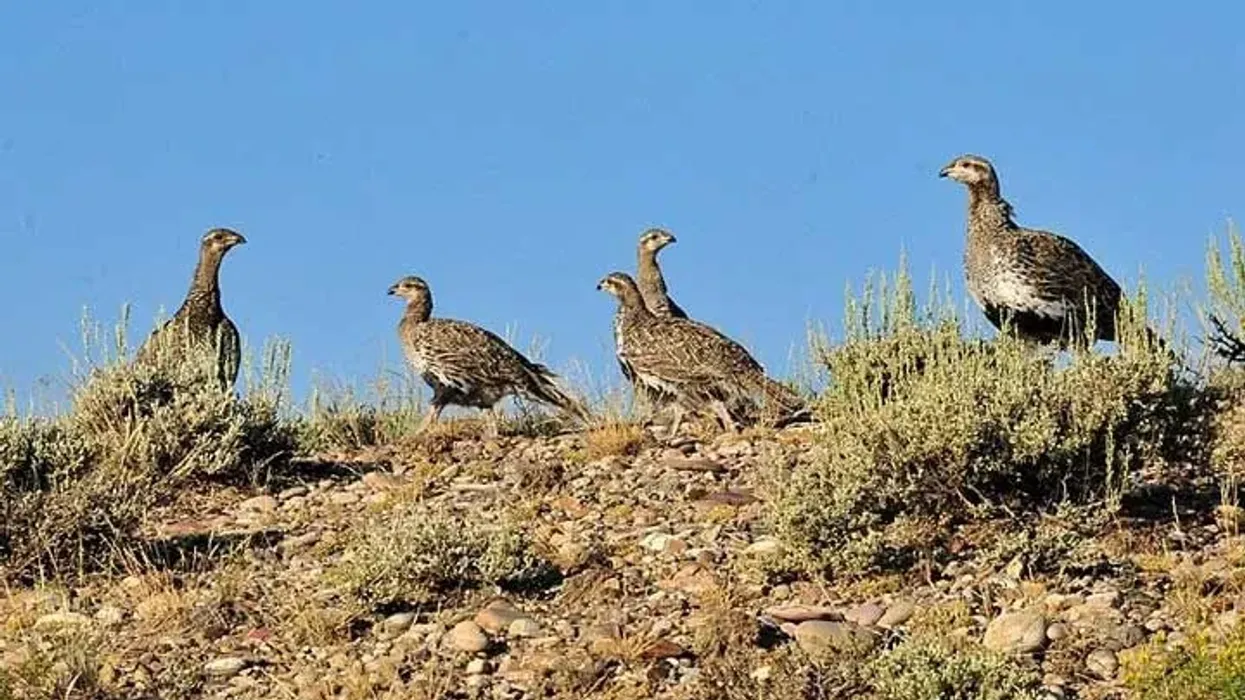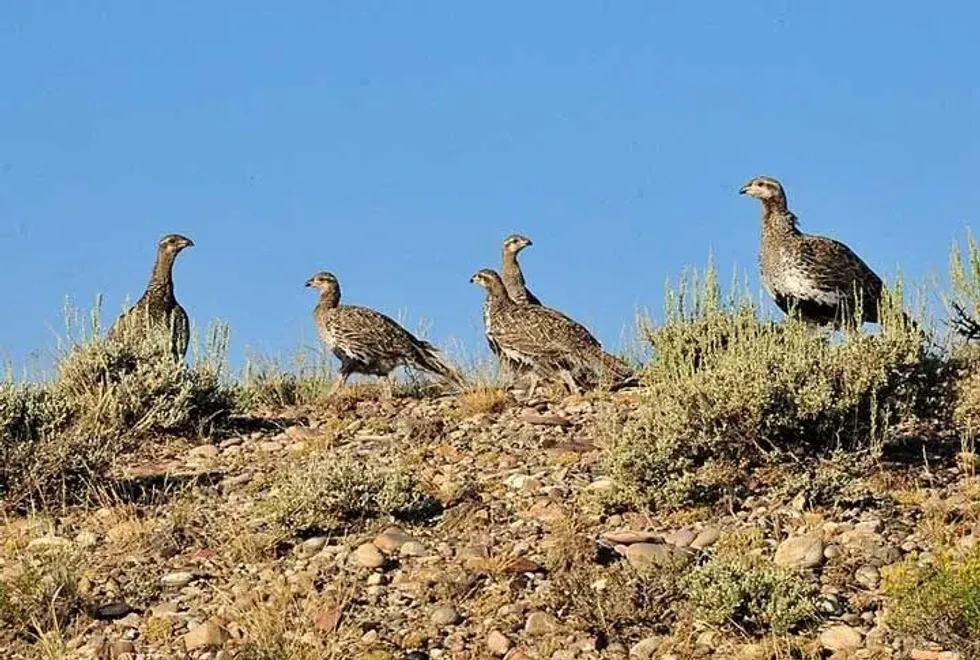Endemic members of the United States, Gunnison grouse or Gunnison sage grouse is a group of heavy-bodied birds with a thick plumaged mane. Scientifically these grouse are recognized by the designation Centrocercus minimus.
These ground-feeding birds exhibit only a few differences, such as smaller size and heavy plume, in comparison to the Centrocercus urophasianus. Until their specific identification in the 2000s, the Gunnison grouse were considered under the same species as the greater sage grouse.
Due to variations in the genetic constitution, the differences between the two closely related species were observed. And hence it was the molecular studies of genetics that lead to the famous designation of Gunnison Sage Grouse as the first species of avifauna to be recognized and recorded from the USA after the 19th century.
In case of piqued interest read ahead to discover some interesting facts about the sage hen. Afterward, do check our other articles on ring-necked duck facts and prairie falcon facts as well.
Sage Hen Interesting Facts
What type of animal is a Sage Hen?
Sage hens are classified as a species of robust birds that are biologically placed under the genera Centrocercus.
What class of animal does a Sage Hen belong to?
Sage hens belong to class Aves as they are birds
How many Sage Hens are there in the world?
The population of the sage hen is facing major threats such as loss of habitat and has experienced a critical plummet over the decades. According to the available data, small groups of about less than 4,000 individuals are known to exist under the sage hen species, which is protected under the Endangered Species Act.
Furthermore, the 2019 survey reported the total population of sage hens inhabiting Colorado to be standing at about 1,800.
Where does a Sage Hen live?
The sage hen is native to the United States. The largest population of these birds is in the Gunnison Basin region in Colorado.
What is a Sage Hen's habitat?
The members of Centrocercus minimus species prefer a variety of grasses, leks, and riparian habitats. Rituals such as nesting, mating, or brooding and behavioral factors play a major role in determining the habitat of these birds.
Who do Sage Hens live with?
Gunnison sage grouses like to flock together. These birds are social and can be seen feeding, stretching, and preening in groups.
How long does a Sage Hen live?
The average lifespan of a sage hen is about three to six years. However, the maximum age was about nine years in the wilderness.
How do they reproduce?
The reproductive cycle in Gunnison sage grouse begins with elaborate courtship rituals. During the breeding season which generally spans from March to May for these birds, the males locate leks.
Leks are areas with low vegetation and high visibility. After migrating to the desired site the males compete for female attention by strutting around, inflating, and deflating the scale-like feather on the air sacs to make popping sounds and fan out their long spiky tail plume.
Aside from courtship dance and mating, the males do not take part in the nesting and rearing of the brood. On average, the female Gunnison sage grouse has about six to eight eggs, which hatch after an incubation period of 25-27 days.
What is their conservation status?
The population of the Gunnison sage grouse is rapidly declining largely due to the loss of habitat of these birds as well as their prey. Hence due to their rapidly declining population, the Gunnison sage grouse is classified as a Nearly Threatened species under the IUCN Red List.
Sage Hen Fun Facts
What do Sage Hens look like?

The Gunnison sage grouse is a species of heavily built birds with long tails and anatomically small heads. The chest of the male sage hen is adorned with two yellow air sacs with scale-like feathers.
The plume behind the neck is thick and white.
The belly of the male avians is black and their throat is separated by the white V-shaped plume forming the mane. In comparison to their male counterparts, the females are smaller and grey or brown-shaded with tails that lack the thick plumage as well as length noticeable in the male members of the species.
How cute are they?
On a scale of one to five, the male members of the sage hen species can easily gain a four for their elegant and majestic looks. While a female may stand at three with less attractive plumage.
How do they communicate?
The Centrocercus minimus usually communicates by vocalizations, callings, and signaling with feathers. Since these are also territorial birds, Centrocercus minimus uses calls to issue warnings to other birds. They also communicate their affection and desire to mate using actions and physical movements.
How big is a Sage Hen?
The average size of these birds is 12.6-20 in (30-45cm) with an estimated height of around 2 ft (60cm).
How fast can a Sage Hen fly?
Though the members of the sage hen species are heavily built, yet they are quite swift in their flight. The estimated flying speed is about 50 mph. However, they prefer walking.
How much does a Sage Hen weigh?
The weight of sage hens ranges between 4-8 lb (1.8-3.6kg) for males and 2-4 lb (0.9-1.8kg) for females.
What are the male and female names of the species?
There are no sex-specific names for sage hens.
What would you call a baby Sage Hen?
The offspring of the Gunnison sage grouse are referred to as young ones, juveniles, nestlings, or fledglings.
What do they eat?
Sage hens are omnivores. The diet of these birds differs with age group and season. In general sagebrush leaves, forbs and a variety of insects constitute their diet.
Are they aggressive?
Like any other animal, the Sage Hen is usually only dangerous when provoked or threatened. Otherwise, these birds don’t pay much heed to humans even if they are around them. They evade human company.
Would they make a good pet?
No, the sage hen would not make for a good pet. The main reason is that this species is a wild species that thrive in the wild, where it takes advantage of the open skies and soars about. In fact, according to the available data, the lifespan of these birds in captivity is reported to decline significantly.
Did you know...
To woo a potential partner, the male members, besides executing the dance and display, emit loud calls while placing them in the proximity of the potential female. Following this, the females generally settle on the male Sage Hen with the loudest vocals.
What is Sage Hen used for?
People eat sage hen by cooking it either in a stew or boiled. Eating sage is normal among people in America as it is considered a delightful dish.
The Dance Of A Sage Hen
The dance of a sage hen is, in fact, one of the defining characteristics of the species. The male members of the species are known to hold elaborate and special displays to woo potential females for mating.
The dance is executed in defined areas called leks. After gathering in leks, the robust males use their anatomy to dance. Inflation and deflation of the scale-like feather marking the air sacs of the male Sage Hens cause popping sounds.
This is followed by the fanning of the long spiky plumage of their tails. Often the males of the species are seen fighting using their wings during these rituals.
Here at Kidadl, we have carefully created lots of interesting family-friendly animal facts for everyone to discover! Learn more about some other birds including Northern Shoveler Facts, or Spotted Sandpiper Facts.
You can even occupy yourself at home by coloring in one of our free printable sage hens.










